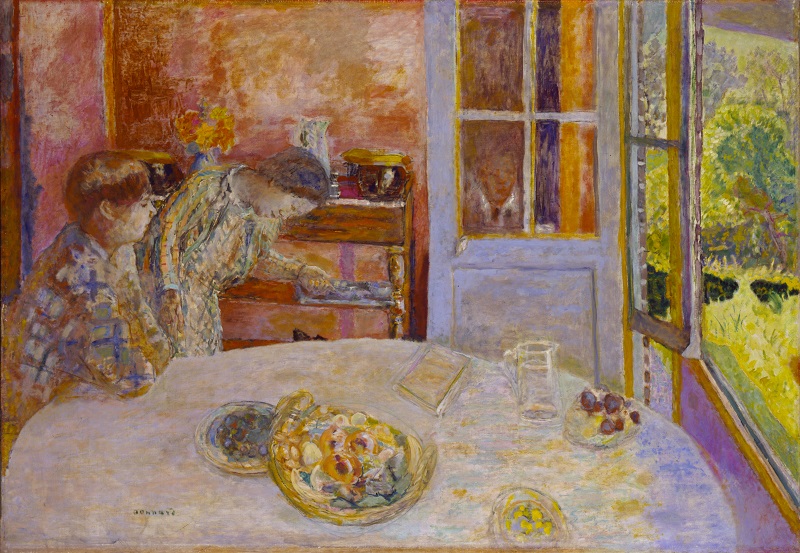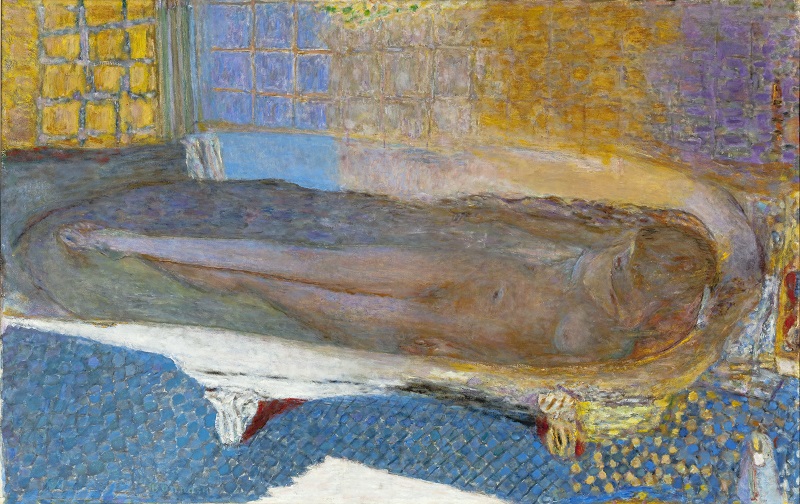“Slow looking” is the phrase du jour at Tate Modern, an enjoinder flatly contradicted by the extent of this exhibition, which in the history of the gallery’s supersized shows counts as a blow-out. Unless you plan to camp overnight, much will need to be skipped through if you are to cast more than a cursory glance over the paintings, drawings and photographs included in this survey of Bonnard’s later career.
It’s not just that it sets ludicrous expectations about the amount of looking to be done in one hit: somewhere in this endless assault by colour is a note linking Bonnard’s reliable market value to his cheerful, easy-on-the-eye palette. Bonnard himself warned of the potential for dissonance between colour and meaning when he remarked, “He who sings is not always happy”, and this stack of around 100 paintings is a fulsome invitation to wallow aimlessly in colour. Implicit is the expectation that we will do no more than merrily skate over the surface, which does nothing to advance the thorough reassessment that such a significant survey ought to entail.
Spanning the years from 1900 until the artist’s death in 1947, Bonnard: The Colour of Memory deals with landscapes and domestic scenes, portraits and still-lifes that zing with colours fresh from the artist’s imagination. For all their ubiquity, Bonnard’s laden tables and views through windows are painted not from life, but from memory. Strange crops and viewpoints and vivid colours give them a dreamlike quality, veiled in emotion that is fine-tuned and concentrated in the remembering. At the beginning of the exhibition, we are encouraged to think of Bonnard’s as an essentially photographic way of seeing. Tiny prints of nude women, or of family groups, with figures sometimes sharp and sometimes blurred with movement, are snapshots even when posed. They coincide with the sudden advent of amateur photography, made possible in 1895 when Kodak launched a handheld camera that was not only easy to carry about, but that supported home printing once the negatives had been processed. Figures tumble towards the camera, sometimes at the edges of a frame, sometimes aware that they are being photographed, at other times not, qualities that find their way into Bonnard’s paintings, too.
At the beginning of the exhibition, we are encouraged to think of Bonnard’s as an essentially photographic way of seeing. Tiny prints of nude women, or of family groups, with figures sometimes sharp and sometimes blurred with movement, are snapshots even when posed. They coincide with the sudden advent of amateur photography, made possible in 1895 when Kodak launched a handheld camera that was not only easy to carry about, but that supported home printing once the negatives had been processed. Figures tumble towards the camera, sometimes at the edges of a frame, sometimes aware that they are being photographed, at other times not, qualities that find their way into Bonnard’s paintings, too.
The composition and high viewpoint of Coffee, 1915 (main picture), suggests a photograph, hastily taken – taken in passing, even. We might recognise the woman drinking coffee as the subject, but she is squeezed into a narrow space at the top of the canvas, in striking contrast to the great expanse of tablecloth that extends into the foreground. A woman’s arm reaches across the table, her head almost completely cut off, her hand slightly blurred with movement as it places or removes a something that might be a glass.
Elsewhere, it is not only the compositional idiosyncracies of the camera that interest Bonnard, but the act of mediated looking. Mirror Above a Washstand, 1908, was painted some years before the onset of his consuming interest in colour, and in a palette of greys and blues he creates a picture within a picture, the nude subject of the painting seen reflected in a mirror, her figure cropped in a way that recalls a view through a lens.
The comparison with Bonnard’s friend Monet also provides some insight into Bonnard’s artistic motives. Monet observed scenes obsessively, painting them at different points in the day and year to record the effects of changing light. Bonnard also returned to favourite subjects, particularly the view from the dining room onto the garden of his Normandy holiday home (pictured above: The Dining Room, Vernon c.1925). But Bonnard was not looking for lengthening shadows, or colours mixed in sunlight and rain, but rather the recollection of these things, tempered by the melancholy of time lost. This is not to say he was not acutely observant. But in the marking of time, Bonnard’s observations are made with a chilly detachment that subjects his models, particularly Marthe de Méligny, his long-term partner and eventually his wife. In Room 11, time and again Marthe is the model for large-scale paintings of bathers: sometimes she is in the bath, sometimes out of it; in one painting she leans against the bath edge, lost in thought, Bonnard’s by now familiar high viewpoint emphasising the very evident power imbalance between them. There’s nothing erotic about Marthe’s baths – she took them as part of a therapeutic regime prescribed to alleviate a battery of mysterious illnesses. At times Bonnard’s relentless looking at her seems almost sadistic – there is no question of these paintings serving as portraits, and though we see her body often, as a woman she becomes no more familiar to us.
This is not to say he was not acutely observant. But in the marking of time, Bonnard’s observations are made with a chilly detachment that subjects his models, particularly Marthe de Méligny, his long-term partner and eventually his wife. In Room 11, time and again Marthe is the model for large-scale paintings of bathers: sometimes she is in the bath, sometimes out of it; in one painting she leans against the bath edge, lost in thought, Bonnard’s by now familiar high viewpoint emphasising the very evident power imbalance between them. There’s nothing erotic about Marthe’s baths – she took them as part of a therapeutic regime prescribed to alleviate a battery of mysterious illnesses. At times Bonnard’s relentless looking at her seems almost sadistic – there is no question of these paintings serving as portraits, and though we see her body often, as a woman she becomes no more familiar to us.
In Nude in the Bath, 1936-8, Marthe is barely there, her head rendered in the same murky blue as the water. Elsewhere, as in Nude in an Interior, c. 1935, she is no more than a decorative element in a visually exciting composition, half seen – hiding, it is tempting to think. In among these scenes of Marthe in her chilly bathroom, Bonnard’s self-portrait appears, reflected in the bathroom mirror. His world is revealed as limited and joyless, and though his work can at times be beautiful, or exciting, or clever, it never seems to resolve – if clarity comes from this enormous collection of paintings, it is that Bonnard reiterates without progress.
- Pierre Bonnard: The Colour of Memory at Tate Modern until 6 May
- Read more visual arts reviews on theartsdesk









![SEX MONEY RACE RELIGION [2016] by Gilbert and George. Installation shot of Gilbert & George 21ST CENTURY PICTURES Hayward Gallery](/sites/default/files/styles/thumbnail_125_x_125_/public/mastimages/Gilbert%20%26%20George_%2021ST%20CENTURY%20PICTURES.%20SEX%20MONEY%20RACE%20RELIGION%20%5B2016%5D.%20Photo_%20Mark%20Blower.%20Courtesy%20of%20the%20Gilbert%20%26%20George%20and%20the%20Hayward%20Gallery._0.jpg?itok=3oW-Y84i)





Add comment